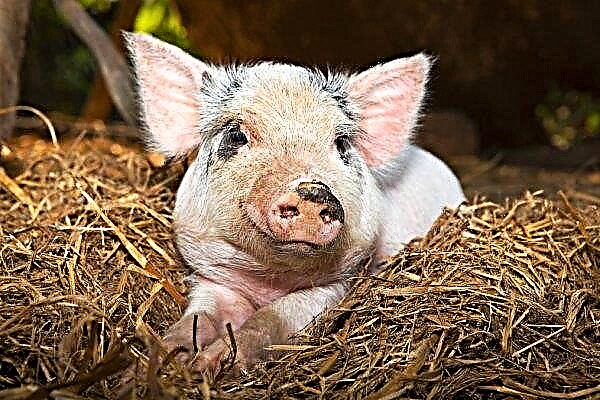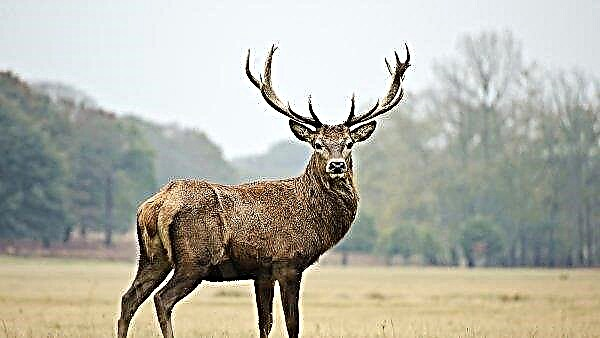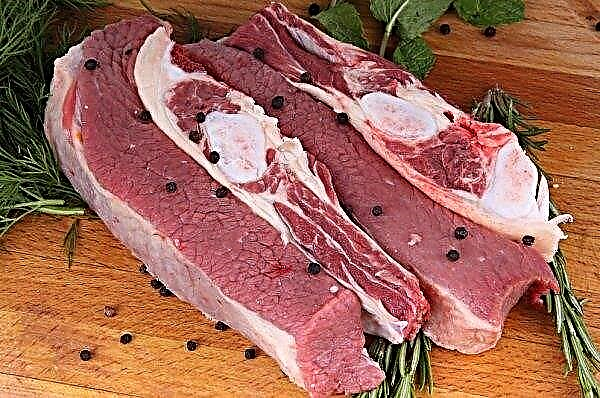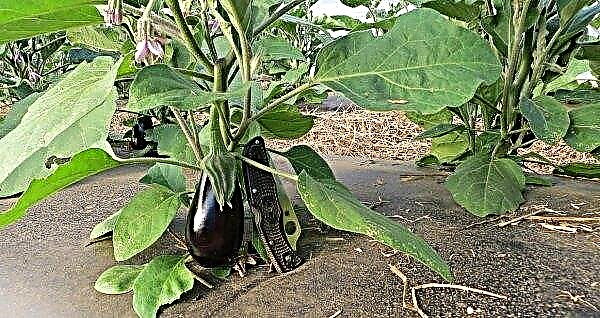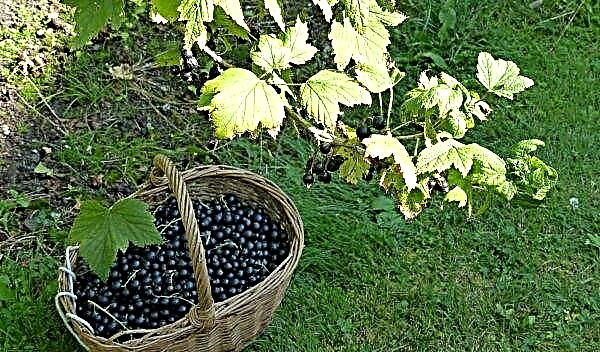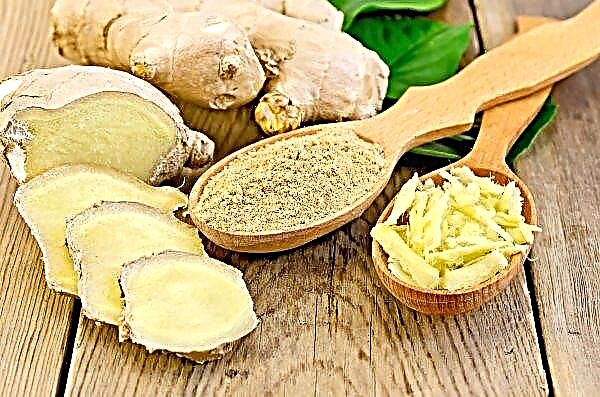Young branches of dill are often used to make salads from fresh vegetables. The aroma of fresh herbs helps increase appetite and improves the taste characteristics of the dish, so many farmers want to grow dill solely for greenery, that is, varieties that do not form umbrellas. In this article, we will find out whether dill exists without umbrellas, consider the description of the most famous plant varieties and the features of their cultivation.
Is there dill without umbrellas
Young dill has very tender and juicy greens. But after the formation of umbrellas, the stalk of the plant becomes stiff and is no longer suitable for fresh consumption.
Did you know? The essential oils contained in dill help clear the airways of sputum during colds.
The formed umbrellas contain seeds, with the help of which the plant reproduces, therefore dill does not exist without umbrellas, this part is vital for the plant. But there are special types of this spicy grass, in which umbrellas are formed quite late.
In addition, these plant species are also characterized by such qualities:
- high productivity;
- persistent and pleasant aroma;
- beautiful leaf shape;
- saturated color of green mass.
All this allows the use of fragrant greens in their fresh form as long as possible and prevents the rapid aging of plants.

Classification
Choosing a variety of dill for growing on your site, you need to familiarize yourself with its characteristics and features of plant care. Depending on the size of the bush, the ripening period and the place of cultivation, all varieties can be divided into several groups. Consider a brief description of the best varieties belonging to each of these groups.
To size
All varieties of dill, which are grown in order to obtain greenery, can be divided into two large groups depending on the size of an adult plant. There are plants growing in a voluminous and sprawling bush, which take up a lot of space on the garden, but allow you to get the maximum yield. Low bushes look very compact and have a lower yield, but they can be grown not only in open ground, but also indoors.
Bush
Plants belonging to this group have the form of a spreading bush. Under conditions of proper care, they can produce a plentiful crop and are characterized by long-term seed ripening, which allows longer use of dill as aromatic greens.
The best varieties of this group are:Important! Shrub varieties of dill require a sufficient amount of free space and need thinning rows.
- Patterns. Plants grow quite slowly and do not exceed a height of 1 m, but with proper care give a high yield of 50 g of greenery from one bush. The leaves are large in size and persistent aroma, grow from the root itself. Harvested 2 months after the appearance of green sprouts. This variety is immune to fungal diseases and contains a lot of vitamin C.

- Gourmet. Its height usually does not exceed 20 cm. Dill has dark green leaves and gives a high yield, which ripens in just 1.5 months. Plants have a persistent aroma and are not picky in care. The variety is characterized by resistance to cool weather and is practically not affected by disease.

- Bushy. The plant requires a lot of space in the garden, and its height is about 1.5 m. It is characterized by soft leaves of a dark green color, exuding a pleasant aroma. Dill ripens in 40 days and does not require specific care. The yield from one bush is about 30 g of spicy greens, which for a long time retains an attractive appearance.

On the greens
Dill, belonging to this group, has a small height, but is characterized by a particularly strong aroma and beautiful appearance. Its leaves have a rich green color and a pleasant fresh taste.
The best varieties of dill on greens are:
- Further;
- Max;
- Grenadier;
- Gribovsky;
- Alligator.
A more detailed description of the listed species will be discussed later in the article.
At the place of cultivation
It is not always possible to grow greens in open ground. Sometimes you want to treat yourself to fragrant herbs in early spring or even in winter, so the plant is often planted in greenhouses and even on window sills. But not all varieties can produce equally good crops under different growing conditions.
Below we consider a list of the most popular types of dill on greens, which are best suited for planting on the street, growing in a greenhouse or in a pot on a windowsill.Did you know? If you hang bunches of dill in the corners of the room, then the aroma of spices will frighten off insects.
For open ground
If possible, spicy greens should be grown in open ground.
The best varieties of plants that can be grown outdoors include:
- Further. Harvest maturity can reach 45 days. The plant has a height of about 30 cm and consists of several green stems, each of which is covered with bright green leaves. Yields can reach 2.5 kg / 1 m², so this dill is often grown for industrial purposes. The advantage of this variety is a good immunity to diseases and resistance to pest attacks.

- Max. The bushes of this species on the bed look very compact, their height does not exceed 15 cm. The leaves of the plant resemble a rhombus in shape and densely cover the stems. The first crop ripens approximately 1.5 months after sowing the seeds. Thanks to the dense green mass from one bush, you can get up to 50 g of fresh fragrant herbs.

- Kutuzovsky. Dill can reach a height of 1 m. This variety combines high productivity, early ripening and excellent taste characteristics. Its leaves are round in shape and form a lush green tops of plants. It takes about 1.5 months to ripen the crop. In this case, from one bush you can collect up to 30 g of fragrant greens, which has a pleasant taste.

For the greenhouse
When growing dill in a greenhouse, the plant receives insufficient sunlight, which can negatively affect the quantity and quality of the crop, so when growing dill on greens in a greenhouse, only those varieties can be selected that can grow in such conditions.
The best varieties of plants for the greenhouse include:- Umbrella. Dill can grow up to 2 m in height, so you need to plant it in a high greenhouse. The leaves of the plant are very fragrant, have a bright green color and consist of many threadlike segments. Harvest ripens after 45 days. From one bush you can get up to 20 g of greenery.

- Frost. The plants are tall - about 1.5 m. The foliage is large and dense, has a bluish-green color, and its upper surface is covered with a thin waxy coating. The first crop of greens can be harvested 1.5 months after seed germination. Productivity can reach 2.7 kg with 1 m². Leaves have a very strong aroma.

- Kibray. Dill of this variety is characterized by rapid growth and has particularly juicy, fragrant leaves. Before the formation of peduncles, the height of the plant can reach 40 cm. On the bed, it requires a lot of space, as it grows in a spreading bush. The first crop can be harvested 3-4 weeks after sowing. With good care from 1 m², you can get up to 5 kg of spicy greens. The advantage of the variety is persistent immunity to fungal infections.

For windowsill
If it is not possible to plant dill in a greenhouse or open ground, you can choose varieties that are suitable for growing indoors. If you create the right microclimate for plants, they can also give a generous harvest of spicy and fragrant herbs.
Important! To plant dill on the windowsill, choose a deep and long flowerpot, on the bottom of which a thick layer of drainage is necessarily laid.
The best varieties of this group include:
- Gribovsky. Plants are well adapted for growing indoors and are unpretentious in care. The height of the bush does not exceed 25 cm, and the first greens can be collected from it already 38 days after planting. The yield from one plant is about 30 g. Dill of this variety needs nutritious and loose soil, so you need to use fertile soil for planting, not forgetting to periodically feed the plants with fertilizers during the growth process.

- Grenadier. The plant reaches a height of not more than 30 cm. Its leaves have a rich emerald color and strong aroma. Harvest ripens 30 days after planting and can reach 2-3 kg of fragrant greens with 1 m², subject to abundant and timely watering.

- Salute. Dill reaches a height of about 55 cm. The leaves of the plant are collected in bulky rosettes and have long petioles. A characteristic feature of the variety is that the leaves never turn yellow, while maintaining an attractive fresh appearance. The first crop of fragrant greens can be cut already after 2 months after sowing seeds. The yield from one bush is about 95 g of greenery. These plants almost do not form peduncles, so you can collect fresh herbs from them several times a season.

By maturity
Varieties of dill on greens differ from each other in terms of ripening. Depending on what period of time it is planned to harvest spicy greens, early ripe or later plant varieties are chosen. In the first case, the crop ripens by the beginning of summer, and in the second - from July to September. Consider the classification of dill by maturity in more detail.
Early ripe
Such varieties can be grown in order to obtain fragrant herbs in late spring. But these plants quickly form umbrellas and do not have time to grow a lush green mass, therefore, the yield of early ripe varieties of this crop is not very high, and when growing dill for greens, they are selected quite rarely.
Did you know? Under the microscope, the thin stalk of dill looks like a solid structure, consisting of thin fibers that strengthen each other and perfectly located cells.
Consider the list of the best early ripening varieties:
- Umbrella. Plants do not exceed 1 m in height and give the first crop of fragrant greens 35 days after sowing seeds. The leaves are painted in bright green color and collected in small sockets, have good taste and pleasant aroma. From 1 m², you can collect up to 5 kg of fragrant herbs. In order to maximize productivity, it must be grown in high humidity and regularly apply nitrogen-containing fertilizers.

- Redoubt. The plant is low, but has a well-developed root system. This variety demonstrates high yields - up to 50 g of greens from one plant. The leaves are narrow and painted green, collected in a slightly raised outlet. Ripening occurs 40 days after sowing seeds. Due to its rich aroma, this variety is often used for the preparation of canned preparations for the winter.

- Aurora. This variety is undersized, but the bush on the bed looks sprawling. You can pick up the first crop from the bush 30 days after planting. The leaves have a bright green color and form a dense and lush rosette. Dill has a delicate taste and unique aroma. From one plant you can collect about 15 g of delicious herbs. The plant is immune to almost all common diseases and is slightly susceptible to attack by pests.

Mid-season
The advantage of growing mid-ripening varieties is that they ripen quite quickly, but still 2–2.5 weeks later than the early ripe varieties of the plant. As a result of this, the bushes have a lush green mass, which leads to an increase in crop productivity.
The best dill varieties with medium ripening dates include:
- Amazon. The height of the bush is about 1.6 cm. The leaves are large, painted in a bluish-green color and form a lush crown on the bush. This variety belongs to one of the most productive, without requiring special care. Before the harvest, the greens pass no more than 50 days, and the leaves differ in juiciness and mouth-watering aroma. In good growing conditions, from one bush you can collect up to 65 g of green dill.
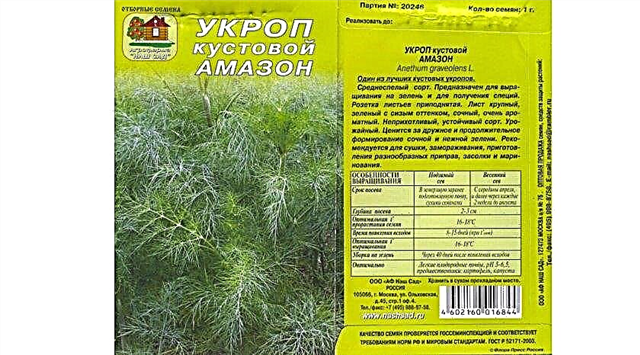
- Richelieu. Bushes can reach 1.2 m in height and have a very lush green mass. The width of one bush can reach 30 cm, and large leaves are collected in bulky rosettes. The structure of the leaf is openwork, it consists of filamentary segments having a bluish-green color. The green mass of the bush has a pleasant aroma, with normal care from 1 m², you can collect 1.2 kg of greenery. The first harvest can be carried out after 40 days. Umbrellas are formed only in the second half of summer.

- Heavy leaf. The height of the plants is about 1.3 m, but on the bed they look very compact. Fresh greens can be cut off after 1.5 months after emergence. The leaves are covered with a small layer of wax, have a rich green color and good taste. Productivity is about 3 kg / 1 m².

Late ripening
When growing dill on greens, you can choose late-ripening plant varieties that ripen only in September. This will allow you to get fresh herbs throughout the summer until the fall and use it not only for making fresh salads, but also for preservation.
Important! In the northern regions, late-ripening dill varieties do not have time to form umbrellas before the onset of cold weather, so it is recommended to prune them immediately.
The best late-ripening dill varieties include:
- Alligator. The plant reaches a height of only 30 cm, but it has large and very fragrant leaves. The ripening of the first green occurs 1.5 months after emergence. Productivity can reach 65 g from one bush, and the umbrella begins to form only at the end of summer.

- Mischievous. This variety belongs to tall, dill bushes can reach 1.3 m in height. The leaves of the plant resemble small rhombuses, and their surface is covered with a waxy coating. Subject to the growing conditions, the variety yields a high yield, but does not require specific care. From 1 m² you can collect up to 3 kg of fragrant herbs. An umbrella does not form for a very long time, so you can cut fresh greens throughout the summer.

- Dill. The variety is of Dutch origin and is characterized by rapid growth. The plant can reach a height of up to 1.5 m, and its green leaves have an unobtrusive taste and lasting aroma. The diameter of the bush is about 18 cm. It takes about 35 days to ripen a harvest of greenery. This variety can be grown in any type of soil. Productivity is at least 2.5 kg / 1 m², while the green mass remains soft and juicy for a long time.

How to grow dill in the garden
Dill belongs to unpretentious crops, and its seeds are characterized by good germination, so even a novice gardener can grow it in the garden. But in order to get a rich and high-quality harvest of fresh herbs, you need to follow some recommendations for planting a plant and carry out a little care for green shoots.
Landing
To improve seed germination, it is recommended to place them in a damp cloth for two days before planting, and then dry them slightly in the sun.
The timing of planting dill depends on where it will be grown:Did you know? In ancient Rome, winners of the competition used not only laurel leaves, but also odorous stalks of dill as material for wreaths.
- when planting in open ground in the southern regions with early spring, seeds can be sown in the soil already in mid-April, but only if the night air temperature does not drop below 0 ° C;
- in the northern regions, seeds are planted in open ground in the second half of May, since until this time there is a high probability of night frosts that will destroy the seeds;
- during autumn planting, seeds are placed in the soil in the second half of October or early November, seedlings appear in early spring;
- in the greenhouse and on the windowsill, dill can be planted on greens year-round, provided that the air temperature in the room does not fall below + 10 ° С.

When choosing a place for planting dill, you must adhere to such recommendations:
- the culture can be grown next to cucumbers, potatoes, garlic and onions, any vegetables other than celery are considered good predecessors for it;
- the plant does not tolerate stagnation of water in the soil, so groundwater in the selected area should not be too close to the soil surface;
- the site should be well lit by the sun;
- the soil should be fairly loose with a neutral level of acidity.
- Dig small furrows in the ground at a distance of at least 20-30 cm from each other.
- Each furrow needs to be slightly poured with warm water, and organic fertilizers should be put on the bottom.
- Place seeds in the furrow, placing them at a distance of about 2 cm from each other.
- Sprinkle a furrow on top of the ground and slightly compact it.
- Cover the bed with the seeds sown with a film until green sprouts appear.
Care
After the planted seeds sprouted, the plant needs some care. The crop volume will depend on its correctness, so it is important to know how to care for dill.
The main growing recommendations are listed below:Important! Do not apply too much fertilizer containing nitrogen. As a result, dill greens accumulate a lot of nitrates and can be harmful to the body.
- it is recommended to cover young seedlings in early spring at night with a layer of film in order to protect them from possible frosts;
- watering beds with fragrant grass should be done with warm water at least 2 times a week so that the earth around the bushes does not dry out;
- after the appearance of green seedlings, weeds must be carefully removed between rows so that they do not absorb moisture and nutrients from the soil;
- the topsoil after each watering needs to be loosened to improve access of water and air to the roots of the plant;
- thinning of rows is carried out after the dill sprouts grow to a height of 10 cm, leaving a distance of at least 20 cm between them. At the same time, lateral shoots of plants are removed so that the bushes do not overshadow each other during growth;
- if the soil was well fertilized before planting, then additional fertilizing of this culture is not required. You can make fertilizers from mullein and urea several times during the season, adding them to water and using a solution to water the beds.

























